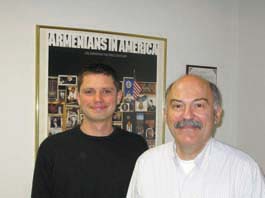Evelyn Demirchian
Staff Writer

On February 24, the Armenian Studies Program welcomed young graduate student and scholar Konrad Siekierski to Fresno State, to give a power-point presentation on the topic of “Folk Religiosity in Contemporary Armenia.”
Sikierski graduated with an M.A. in Ethnology from the Institute of Ethnology and Cultural Anthropology of the University of Warsaw, Poland. He has been doing research in Armenia for his Ph.D. thesis, examining the relations between religious and national identities.
In 2001 Siekierski visited Turkey, at the same time visiting Armenian churches and historical sites, such as Aghtamar, Van, and Ani. This inspired him to visit the Republic of Armenia and when deciding on a topic for his M.A., he proposed to study the contemporary religious situation in Armenia. In 2004 Siekierski arrived in Armenia to begin the field-work for his degree and was later invited to complete his Ph.D. with the Institute of Archaeology and Ethnography of the National Academy of Sciences in Armenia, where he is working with Dr. Levon Abrahamian, his advisor, and Dr. Hranush Kharatian. Siekierski is fluent in English, Polish, Russian, and Armenian.
The lecture largely focused on the nature of folk religious practices and how people in Armenia are “preserving deeply-rooted traditions and customs.” Siekierski also argued that these practices were not static, but were dynamic, and were about change and invention. The field of study for folk religiosity is fairly large since it encompasses all the ways in which a group of people present or celebrate their beliefs in the superstitious, as well as in major faiths such as Christianity. Folk religiosity in Armenia is a combination of old folk practices, for example a belief in the “evil eye,” and Christianity.
Examples of these practices typically revolve around dreams people have of those who have died or the veneration of Armenian saints. In the dreams many are told to go look for symbolic places and holy sites, to give sacrifices, or to build shrines.
One case in the 1980’s involved a man who was told in a dream by an Armenian saint to reveal a holy shrine, and in doing so the man would be rewarded. After following the advice of the Saint, the man became a grandfather and came into the possession of a lot of money.
Yet another case concerned a woman who dreamed of a girl in white. The woman’s mother-in-law saw the same girl in her dreams, and both were told to venture to the Kazakh River with a shovel, walk until they dropped, and in that very spot to dig. Following those directions, the women ventured to the River and walked until they collapsed from exhaustion. The next morning they woke up, dug in the spot they had slept and found a Khatchkar, or cross stone. Other instances of folk religiosity in Armenia involve spiritual homes, and the Armenian tradition of madagh, a traditional offering of an animal at a holy site, shrine, or Church.
The holy places of the folk religious can be in either a ruined church or monastery or a natural place, such as a tree or cave. Most of these holy places are situated in the more rural towns and villages of Armenia, though some examples may be found near the cities of Yerevan and Sevan. The religious practices had been largely abandoned during the Soviet era, but some traditions remained and several have been recreated since the fall of the USSR.
What was also interesting is the dynamic relationship between the official religiosity and folk religiosity. At times the official church frowns upon the practices and at other times some of the holy places are adopted.
Siekierski’s photographs complemented his presentation by giving a vivid visual of the holy places and the practices associated with them.
 Hye Sharzhoom Armenian Action
Hye Sharzhoom Armenian Action